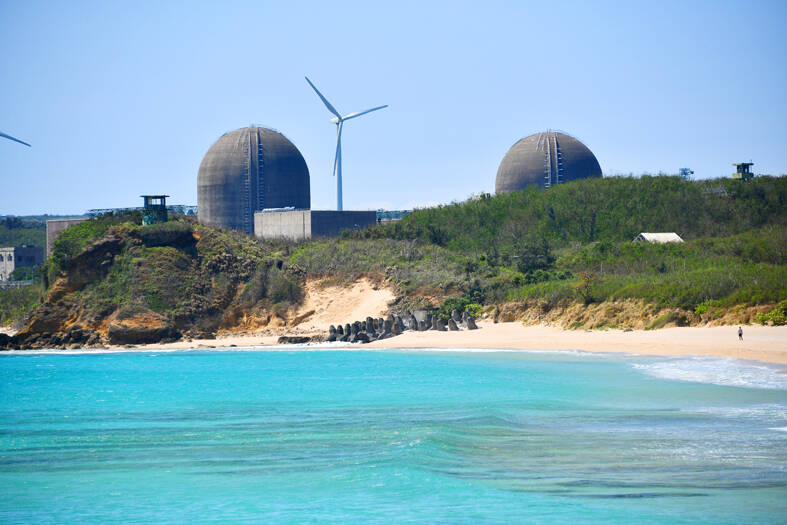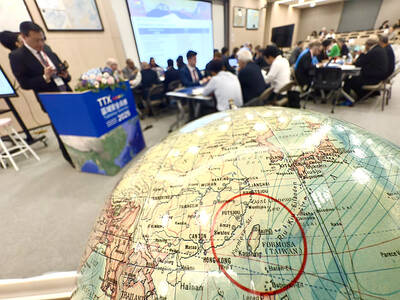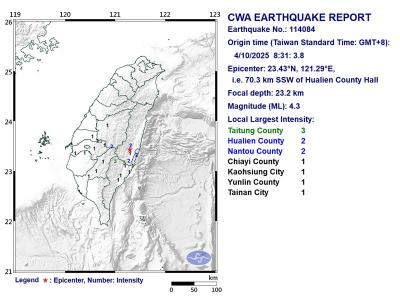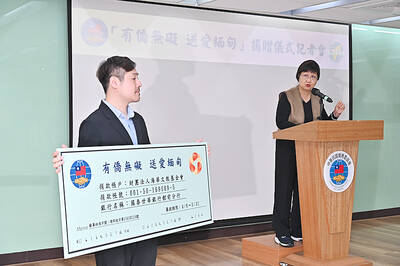The government should lift restrictions on operations of completed nuclear power plants and refrain from excessively subsidizing renewable energy to relieve Taiwan Power Co’s (Taipower) financial deficit, lawmakers and environmental groups said at a news conference in Taipei yesterday.
The US and Japan are going back to nuclear energy, as it ensures a low-cost, stable supply of power, Taiwan People’s Party Legislator Chang Chi-kai (張?楷) said, citing American Institute in Taiwan Director Raymond Greene.
Chinese Nationalist Party (KMT) Legislator Huang Chien-hao (黃健豪) said that claims by many politicians that “no nuclear safety, no nuclear energy” is a “red herring,” as no Taiwanese have sustained physical harm from nuclear waste since the nation’s first nuclear power plant went online in 1978.

Photo: Tsai Tsung-hsien, Taipei Times
However, air quality worsened and lung cancer rates have increased over the past few years as more fossil fuel-fired electricity was generated in line with the “nuclear-free homeland” policy, Huang said.
Although nuclear waste is a pollutant, fossil fuel power stations cause air pollution, while solar panels and materials for wind power are pollutants as well, he said.
“Each way of generating power has risks, and we should choose the one that poses the least risk to society and helps society advance,” he said.
KMT Legislator Alicia Wang (王育敏) said that nuclear energy must be used, as energy autonomy is critical to national security.
A tabletop exercise held by the Taiwan Center for Security Studies this month showed that Taiwan’s energy security coefficient was a worryingly high 0.99, Wang said.
Although nuclear power is one of the cheapest sources of energy, President William Lai (賴清德) purchases green power from the Philippines, she said.
Adding up all costs from delivering and transmitting green power might be up to NT$8 (US$0.24) per kilowatt-hour (kWh), while the cost of nuclear energy would be less than NT$2 per kilowatt-hour, she said.
Climate Change Pioneering Alliance founder Yang Chia-fa (楊家法), who is also a Taipower technician, said that the company has a deficit of NT$2.66 trillion, not NT$500 billion as Minister of Economic Affairs J.W. Kuo (郭智輝) said on Monday last week.
The NT$560 billion budget for power grid resilience would mostly be invested in wind and solar, for which costs are estimated to rise by NT$25 billion for every 1 percent increase in wind or solar power coverage, Yang said.
LowCarbonPower Ltd Co founder Olof Nordenstam said that the Swedish government has shifted from a goal of “100 percent renewables” to “100 percent low-carbon energy” due to heightened awareness of climate change.
Taiwan’s greatest amount of power generated by low-carbon energy was 557kWh in 2013, but the figure dropped to 486kWh last year, Nordenstam said, citing data from LowCarbonPower.
However, the total amount of power generated by low-carbon energy or fossil fuels continued to increase over the past decade, meaning that the percentage of power generated by low-carbon energy must have declined, he said.
While Taiwan refrained from using nuclear energy, the US has kept nuclear power plants in operation on top of developing green power sources, leading to a growing percentage of power generated by low-carbon energy, he said.
Alliance spokesman Chiang Chao-yuan (江肇元) said that the government’s clean energy policy should be pragmatic and nuclear power should be considered a low-carbon, clean energy option in line with global trends.
Sufficient and stable power supply is indispensable to digital transition and high-tech sectors such as artificial intelligence, biomedicine, smart agriculture and electric vehicles, Chiang said.
Nuclear Myth Busters founder Huang Shih-hsiu (黃士修) said that Premier Cho Jung-tai’s (卓榮泰) remarks on Tuesday last week that a NT$100 billion subsidy for Taipower was to reimburse it for low electricity prices.
The subsidy was to make up for spending on green power procurement, which was NT$119.3 billion, he said.
The Fourth Nuclear Power Plant in New Taipei City’s Gongliao District (貢寮) could have been commercialized and contributed at least 20 terrawatt-hours of electricity annually had it not been mothballed in 2014, he added.

Taiwan is stepping up plans to create self-sufficient supply chains for combat drones and increase foreign orders from the US to counter China’s numerical superiority, a defense official said on Saturday. Commenting on condition of anonymity, the official said the nation’s armed forces are in agreement with US Admiral Samuel Paparo’s assessment that Taiwan’s military must be prepared to turn the nation’s waters into a “hellscape” for the Chinese People’s Liberation Army (PLA). Paparo, the commander of the US Indo-Pacific Command, reiterated the concept during a Congressional hearing in Washington on Wednesday. He first coined the term in a security conference last

DEFENSE: The National Security Bureau promised to expand communication and intelligence cooperation with global partners and enhance its strategic analytical skills China has not only increased military exercises and “gray zone” tactics against Taiwan this year, but also continues to recruit military personnel for espionage, the National Security Bureau (NSB) said yesterday in a report to the Legislative Yuan. The bureau submitted the report ahead of NSB Director-General Tsai Ming-yen’s (蔡明彥) appearance before the Foreign and National Defense Committee today. Last year, the Chinese People’s Liberation Army (PLA) conducted “Joint Sword-2024A and B” military exercises targeting Taiwan and carried out 40 combat readiness patrols, the bureau said. In addition, Chinese military aircraft entered Taiwan’s airspace 3,070 times last year, up about

A magnitude 4.3 earthquake struck eastern Taiwan's Hualien County at 8:31am today, according to the Central Weather Administration (CWA). The epicenter of the temblor was located in Hualien County, about 70.3 kilometers south southwest of Hualien County Hall, at a depth of 23.2km, according to the administration. There were no immediate reports of damage resulting from the quake. The earthquake's intensity, which gauges the actual effect of a temblor, was highest in Taitung County, where it measured 3 on Taiwan's 7-tier intensity scale. The quake also measured an intensity of 2 in Hualien and Nantou counties, the CWA said.

The Overseas Community Affairs Council (OCAC) yesterday announced a fundraising campaign to support survivors of the magnitude 7.7 earthquake that struck Myanmar on March 28, with two prayer events scheduled in Taipei and Taichung later this week. “While initial rescue operations have concluded [in Myanmar], many survivors are now facing increasingly difficult living conditions,” OCAC Minister Hsu Chia-ching (徐佳青) told a news conference in Taipei. The fundraising campaign, which runs through May 31, is focused on supporting the reconstruction of damaged overseas compatriot schools, assisting students from Myanmar in Taiwan, and providing essential items, such as drinking water, food and medical supplies,